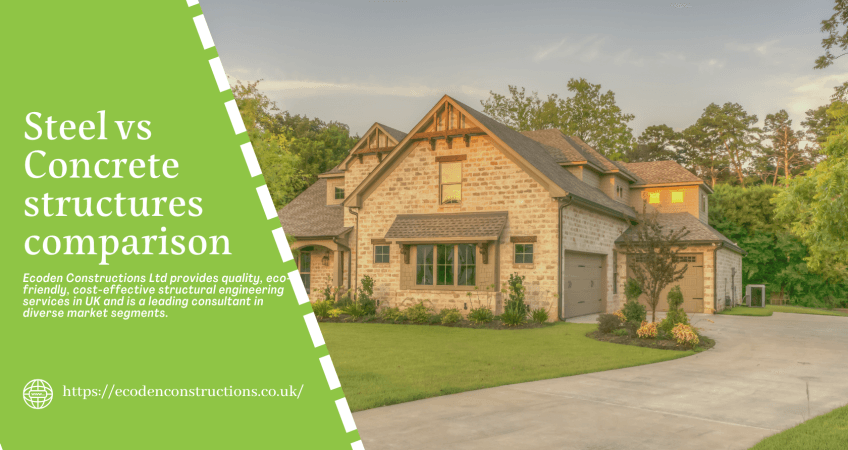Selecting between steel and concrete structures forms the first important decision for any new construction project. Each building material has special benefits and limits so builders should compare properties like sturdiness and speed versus durability and expense. Our complete guide will show you what makes steel structures different from concrete structures.
Understanding Steel Structures
Steel structures are constructed using steel components, which are fabricated and assembled to form a frame capable of supporting loads. This type of construction is commonly seen in high-rise buildings, industrial facilities, and bridges.
Advantages of Steel Structures
- Strength and Durability
- Steel boasts a high strength-to-weight ratio, making it ideal for structures requiring significant load-bearing capacity without excessive weight.
- It can withstand extreme environmental conditions, including earthquakes and hurricanes.
- Construction Speed
- Steel components are prefabricated off-site, reducing construction time significantly.
- The assembly process is faster compared to concrete, minimizing labor costs and project timelines.
- Flexibility and Versatility
- Steel structures can be easily modified or expanded in the future.
- They allow for creative architectural designs due to their flexibility.
- Sustainability
- Steel is 100% recyclable, making it an environmentally friendly choice.
- It contributes to green building certifications and reduces construction waste.
- Lighter Foundation Requirements
- Due to steel’s lightweight nature, foundation requirements are less demanding compared to concrete structures.
Disadvantages of Steel Structures
- Corrosion Susceptibility
- Steel is prone to rust and corrosion if not properly maintained, requiring regular coatings and inspections.
- Fire Resistance
- While steel is fire-resistant, it loses strength at high temperatures, necessitating fireproof coatings for safety.
- Cost Fluctuations
- Steel prices are volatile and can impact project budgets unpredictably.
Understanding Concrete Structures
Concrete structures are composed of cement, water, and aggregates (such as sand and gravel), which harden over time to form a solid, durable mass. Concrete is widely used in residential buildings, bridges, and infrastructure projects.
Advantages of Concrete Structures
- High Compressive Strength
- Concrete excels in compressive strength, making it ideal for foundations, columns, and load-bearing walls.
- Fire Resistance
- Concrete has excellent fire resistance properties, maintaining structural integrity even in extreme temperatures.
- Longevity and Low Maintenance
- Concrete structures have a long lifespan with minimal maintenance requirements.
- Thermal Mass
- Concrete’s ability to store and release heat slowly improves energy efficiency in buildings.
- Availability and Cost Stability
- Concrete materials are widely available and generally more cost-stable compared to steel.
Disadvantages of Concrete Structures
- Heavy Weight
- Concrete is significantly heavier than steel, leading to higher foundation costs and transportation challenges.
- Slower Construction Time
- Concrete requires curing time, which can delay project timelines.
- Cracking and Shrinkage
- Over time, concrete is susceptible to cracking and shrinkage, requiring repairs and reinforcement.
- Limited Flexibility
- Modifying concrete structures post-construction can be challenging and costly.
Key Comparison Factors: Steel vs. Concrete
1. Strength and Load-Bearing Capacity
- Steel: Higher tensile strength, suitable for high-rise and large-span structures.
- Concrete: Superior compressive strength, preferred for foundations and load-bearing elements.
2. Durability and Maintenance
- Steel: Requires protection against corrosion and fire.
- Concrete: More durable with lower maintenance needs but prone to cracking.
3. Construction Speed
- Steel: Faster assembly with prefabrication advantages.
- Concrete: Slower due to curing time.
4. Cost Considerations
- Steel: Higher initial cost but lower labor and time expenses.
- Concrete: Lower material cost but higher labor and maintenance costs.
5. Environmental Impact
- Steel: Recyclable but energy-intensive production.
- Concrete: Non-recyclable but locally sourced materials reduce transportation emissions.
Which is Better for Your Project?
Choosing between steel and concrete structures depends on several factors, including:
- Project Type: High-rise buildings and industrial projects often favor steel, while residential and infrastructure projects prefer concrete.
- Budget: Concrete is generally more budget-friendly, whereas steel offers long-term savings.
- Time Constraints: If construction speed is a priority, steel is the better option.
- Environmental Goals: Steel’s recyclability may align with green initiatives, while concrete’s energy efficiency may suit sustainable projects.
Conclusion
Both steel and concrete structures have their distinct benefits and drawbacks. Steel is ideal for speed, flexibility, and lightweight applications, while concrete offers durability, fire resistance, and cost stability. Understanding your project’s specific needs will guide you in making the right choice between these two construction materials.
By considering factors such as strength, durability, cost, and sustainability, you can ensure your construction project is both efficient and future-proof.



